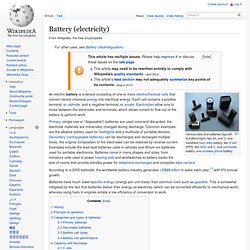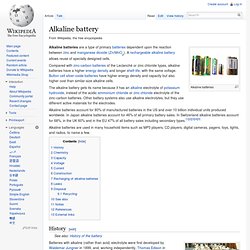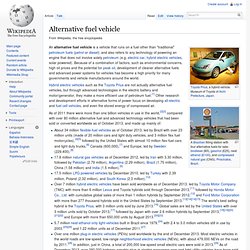

List of battery types. Renewable energy in India. Renewable energy in Africa. The developing nations of Africa are popular locations for the application of renewable energy technology.

Currently, many nations already have small-scale solar, wind, and geothermal devices in operation providing energy to urban and rural populations. These types of energy production are especially useful in remote locations because of the excessive cost of transporting electricity from large-scale power plants. The application of renewable energy technology has the potential to alleviate many of the problems that face Africans every day, especially if done so in a sustainable manner that prioritizes human rights. Access to energy is essential for the reduction of poverty and promotion of economic growth. Communication technologies, education, industrialization, agricultural improvement and expansion of municipal water systems all require abundant, reliable, and cost-effective energy access.[1] Renewable energy in Pakistan. Renewable energy in Pakistan is a relatively underdeveloped sector; however, in recent years, there has been some interest by environmentalist groups and from the authorities to explore renewable energy resources for energy production, in light of the energy crises and power shortages affecting the country.

Most of the renewable energy in Pakistan comes from hydroelectricity. Solar power[edit] There have been some efforts to install and expand the use of solar energy in Pakistan. The average amount of daily sunlight in Pakistan is nine and a half hours[citation needed]; there are a few cloudy days even in the wettest regions. Renewable energy in China. Renewable energy is helping the People's Republic of China complete its economic transformation and achieve energy security.

China has progressed rapidly along the path of renewable energy development.[1] About 17 percent of China's electricity came from renewable sources in 2007, led by the world's largest number of hydroelectric generators.[2] China had a total installed capacity of hydropower of 197 GWatt in 2009.[3] Technology development and increased amounts of investment in renewable energy technologies and installations increased markedly throughout the 2000s in China, and investment in renewable energy is now part of China's economic stimulus strategy.[4] Researchers from Harvard University and Tsinghua University have found that the People's Republic could meet all of its electricity demands from wind power by 2030.[5] Sources[edit] Hydropower[edit] China's installed hydropower capacity surpassed 200 GW in late August 2010.
Wind power[edit] James May's Big Ideas - (3 of 3) Power to the People. Carbon Capture and Storage movie. Fact sheet - Energy Efficiency in Homes. Lighting Efficiency Comparison - Madison Gas and Electric - Madison, Wisconsin. Battery (electricity) An electric battery is a device consisting of one or more electrochemical cells that convert stored chemical energy into electrical energy.

Each cell contains a positive terminal, or cathode, and a negative terminal, or anode. Electrolytes allow ions to move between the electrodes and terminals, which allows current to flow out of the battery to perform work. Primary (single-use or "disposable") batteries are used once and discarded; the electrode materials are irreversibly changed during discharge. Common examples are the alkaline battery used for flashlights and a multitude of portable devices.
Secondary (rechargeable batteries) can be discharged and recharged multiple times; the original composition of the electrodes can be restored by reverse current. Alkaline battery. Alkaline batteries Compared with zinc-carbon batteries of the Leclanché or zinc chloride types, alkaline batteries have a higher energy density and longer shelf-life, with the same voltage.

Button cell silver-oxide batteries have higher energy density and capacity but also higher cost than similar-size alkaline cells. The alkaline battery gets its name because it has an alkaline electrolyte of potassium hydroxide, instead of the acidic ammonium chloride or zinc chloride electrolyte of the zinc-carbon batteries. Other battery systems also use alkaline electrolytes, but they use different active materials for the electrodes. Alkaline batteries account for 80% of manufactured batteries in the US and over 10 billion individual units produced worldwide. Alkaline batteries are used in many household items such as MP3 players, CD players, digital cameras, pagers, toys, lights, and radios, to name a few. History[edit] Sustainable Energy for All. How does a biogas plant work? Biogas technology benefits S Africa's poor. The Future of Renewable Energy - VideoInfographs.com. Electric engine, how does it work ?
How Fuel Cells Work. Alternative fuel vehicle. An alternative fuel vehicle is a vehicle that runs on a fuel other than "traditional" petroleum fuels (petrol or diesel); and also refers to any technology of powering an engine that does not involve solely petroleum (e.g. electric car, hybrid electric vehicles, solar powered).

Because of a combination of factors, such as environmental concerns, high oil prices and the potential for peak oil, development of cleaner alternative fuels and advanced power systems for vehicles has become a high priority for many governments and vehicle manufacturers around the world. How engine works. How Ethanol Is Made Animated Feature. How Photovoltaic Solar Cells Work. Alternative Fuel Vehicles. Alternative fuels are derived from resources other than petroleum.

Some are produced domestically, reducing our dependence on imported oil, and some are derived from renewable sources. Often, they produce less pollution than gasoline or diesel. Ethanol is produced domestically from corn and other crops and produces less greenhouse gas emissions than conventional fuels. Biodiesel is derived from vegetable oils and animal fats. It usually produces less air pollutants than petroleum-based diesel. Internal Combustion" The principle behind any reciprocating internal combustion engine: If you put a tiny amount of high-energy fuel (like gasoline) in a small, enclosed space and ignite it, an incredible amount of energy is released in the form of expanding gas.

You can use that energy to propel a potato 500 feet. In this case, the energy is translated into potato motion. You can also use it for more interesting purposes. For example, if you can create a cycle that allows you to set off explosions like this hundreds of times per minute, and if you can harness that energy in a useful way, what you have is the core of a car engine!
Almost all cars currently use what is called a four-stroke combustion cycle to convert gasoline into motion. Intake strokeCompression strokeCombustion strokeExhaust stroke Figure 1 You can see in the figure that a device called a piston replaces the potato in the potato cannon. Now the engine is ready for the next cycle, so it intakes another charge of air and gas. Energy Skate Park - Conservation of Energy, Kinetic Energy, Potential Energy. The Secret Lives of Energy - The Energy Story - Energy Changes.
Kinetic and Potential Energy. ANGRY BIRDS! (Interactive Game) The Secret Lives of Eenrgy - The Energy Story - Energy Types. Scary giant drop ride Dreamworld. Report reveals worrying teen obesity trend. The Secret Lives of Eenrgy - The Energy Story - Energy Types. Acetylene demonstrations. Energy.